This article possibly contains original research .(November 2020) |
Jean-Jacques Caux, known as Cataline, was the most famous mule packer of the Canadian West.
This article possibly contains original research .(November 2020) |
Jean-Jacques Caux, known as Cataline, was the most famous mule packer of the Canadian West.
Jean Jacques Caux, known as Cataline, was born in rural southern France around 1830, most likely in a town called Oloron in the Bearn region. In 1858 the town joined up with Ste-Marie, so the town then became Oloron-Sainte-Marie.
When he first came to what was later known as British Columbia he packed on a small scale with only one animal. He eventually worked his way up to having larger pack trains with up to 60 animals, according to some, and it is said he had at least four pack trains.
Cataline packed from Yale to Barkerville during the Cariboo Gold Rush, working mostly with experienced Mexican packers. He lived with a NLaka'pamux woman from Spuzzum called Amelia York, native name C'eyxkn. Jean had at least two children with her; the first was William Benjamin, the second was Rhoda Dominic Urquhart. It is also possible that another child, Clara Dominic Clare who had many descendants, was also Jean Caux's child. Genealogical research is being done to ascertain if Jean Caux is actually their ancestor. [1]
In the 1880s, his packing partner was Joe Castillou, another Frenchman who was mistaken as a Spaniard; because of his name they called him 'Castillion'. Joe eventually went his own way from Cataline's pack train, and settled in Merritt, BC, Canada. He is commemorated in the Nicola Valley Museum in Merritt, with his son Henry Castillou, the "Cowboy Judge of the Cariboo", and alongside the display of the famed anthropologist James Teit; a researcher of aboriginal culture who worked for the Chicago Museum of Natural History. Caux and Castillou did some packing trips for James Teit, which is where young Henry acquired his taste for the local culture.
Perhaps people thought Caux & Castillou were Spanish because they used Spanish words for packing, such as secundo and aparejo. It is not hard to determine where these words originated when one remembers that these men grew up at the base of the Pyrenees Mountains, which is the border of Spain & France. However, as most packers in the early years in BC were Mexican, it is most likely that Spanish became the language of the profession for that reason.
Although the exact date of his arrival in British Columbia is unknown, it is recorded that he was packing at the beginning of the Fraser Canyon Gold Rush in 1858 and continued until 1912, a span of 54 years.
Cataline was known to wear the same type of clothing year round: a boiled white shirt, heavy woolen pants, riding boots and no socks. When he had business to conduct, he added a collar, tie and a French hat to his apparel.
One of the most famous stories is that he used to rub liquor into his hair. He would drink his cognac or whisky, leaving a small amount to pour into his hand, and rub it into his hair; saying "A liddle insida, a liddle outsida. Bon! She maka da hair grow!"
On every trip he brought along a chair made of birch and rawhide where he would sit as he negotiated his business, while everyone else sat on the ground. Though it has been said he was illiterate, he had an excellent memory and kept his business records in his head without ever making a single note. He could sign his name with a flourish, so one must wonder if he actually was illiterate, or perhaps just keeping his business to himself.
Cataline's pack train usually consisted of sixty mules. Each outfit also employed six or more men, a foreman, also known as a corregidor, a second man, known as a secundo, a cook and several muleteers. The pack mules could carry 250–300 pounds and could navigate very difficult trails. Cataline's mules were so well trained that when the corregidor rang a signal bell, they would go to their own packs and wait to be loaded. In Cataline's outfit, around the turn of the century, his corregidor was Ah Gun and his secundo was Dave Wiggins.
Even though he used over sixty mules, he knew to the item what each of them carried, where they were being delivered to and what he had to charge. And although he ran mule trains for over half a century it was said he never lost a pound of cargo, except in one instance when his secundo, upon smelling a two-pound package of Limburger cheese, decided it was rotten and threw it away. Once aware of the error, Cataline made sure it was replaced and delivered. Another story about him involves a loan that he had to make after a disease had killed several of his mules. The bank manager questioned Cataline's collateral, wondering how many mules and horses he owned before consenting to lend him the money. When Cataline returned to the bank in the fall to repay the debt, he counted out the exact amount owing and paid it in full. The bank manager noted that Cataline had more money on his person and suggested that he deposit it in the bank. Cataline responded with a query as to how many horses and mules the bank owned, and upon learning it was none, decided to keep his money.
With the completion of the Canadian Pacific Railway, he moved his headquarters to Ashcroft. Amelia remained in Spuzzum, but he continued to support her and her children, always in the form of $20 gold coins. During this period, he was friends with Judge Matthew Baillie Begbie, who once held an impromptu court to provide Cataline with Canadian citizenship when his squatting rights were questioned. In 1897, Cataline led a pack train all the way from Ashcroft, then the southern terminus of the Cariboo Road, all the way to the Yukon Territory. [2]
When the construction of the Grand Trunk Pacific Railway was announced, Cataline moved his operations to Quesnel to better serve the booming Central Interior. He packed throughout the Cariboo, Central Interior and Skeena River district until 1912 when he retired in Hazelton. In 1920 he decided to spend his remaining winters in Victoria, but after spending just one winter in the Dominion Hotel, he returned to Hazelton for the rest of his days. He died in October 1922 at the age of 85 and is buried in the Gitanmaax cemetery. A brass plaque on his cairn simply reads "Jean Caux–Cataline, the packer".
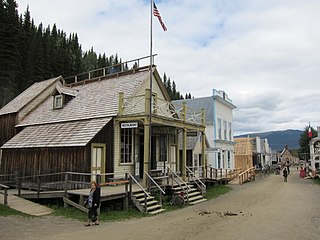
Barkerville was the main town of the Cariboo Gold Rush in British Columbia, Canada, and is preserved as a historic town. It is located on the north slope of the Cariboo Plateau near the Cariboo Mountains 80 kilometres (50 mi) east of Quesnel. BC Highway 26, which follows the route of the Cariboo Wagon Road, the original access to Barkerville, goes through it.

Hazelton is a village located at the junction of the Bulkley and Skeena Rivers in northern British Columbia, Canada. It was founded in 1866 and in 2011 had a population of 305. The nearby larger community of New Hazelton is the northernmost point of the Yellowhead Highway, a major interprovincial highway which runs from Prince Rupert, British Columbia, to Portage la Prairie, Manitoba.

Williams Lake is a city in the Central Interior of British Columbia, in the central part of a region known as the Cariboo. Williams Lake is one of the largest cites, by population of metropolitan area, in the Cariboo after neighbouring Quesnel. The city is famous for the Williams Lake Stampede, which was once the second largest professional rodeo in Canada, after only the Calgary Stampede.
Spuzzum is an unincorporated community in the lower Fraser Canyon area of southwestern British Columbia, Canada. The place is on the west shore of the Fraser River and north shore of Spuzzum Creek. The locality, on BC Highway 1, is by road about 40 kilometres (25 mi) north of Hope and 69 kilometres (43 mi) south of Lytton.
British Columbia gold rushes were important episodes in the history and settlement of European, Canadian and Chinese peoples in western Canada.

The Cariboo Road was a project initiated in 1860 by the Governor of the Colony of British Columbia, James Douglas. It involved a feat of engineering stretching from Fort Yale to Barkerville, B.C. through extremely hazardous canyon territory in the Interior of British Columbia.

The Fraser Canyon is a major landform of the Fraser River where it descends rapidly through narrow rock gorges in the Coast Mountains en route from the Interior Plateau of British Columbia to the Fraser Valley. Colloquially, the term "Fraser Canyon" is often used to include the Thompson Canyon from Lytton to Ashcroft, since they form the same highway route which most people are familiar with, although it is actually reckoned to begin above Williams Lake at Soda Creek Canyon near the town of the same name.

Barnard's Express, later known as the British Columbia Express Company or BX, was a pioneer transportation company that served the Cariboo and Fraser-Fort George regions in British Columbia, Canada from 1861 until 1921.
The Old Cariboo Road is a reference to the original wagon road to the Cariboo gold fields in what is now the Canadian province of British Columbia. It should not be confused with the Cariboo Road, which was built slightly later and used a different route.
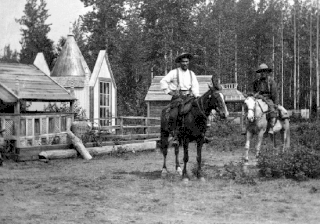
Simon Gunanoot was a prosperous Gitxsan man and a merchant in the Kispiox Valley region of Hazelton, British Columbia, Canada. He lived with his wife and children on a large ranch. A posse sought him after a murder but he escaped, retrieved his family and hid out. Eventually he surrendered and stood trial. He was found not guilty. The case garnered extensive media coverage and Gunanoot became a figure of legendary status.
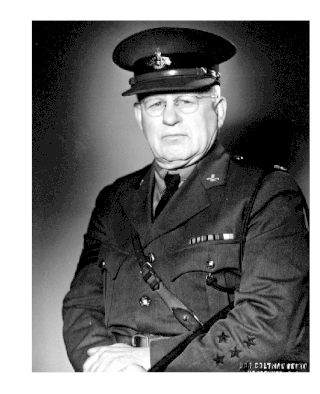
Sperry Cline, DCM was a Canadian frontier policeman and author in British Columbia.
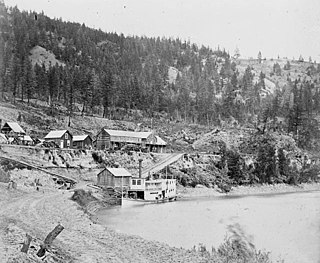
The Enterprise was a passenger and freight sternwheeler that was built for service on the Soda Creek to Quesnel route on the upper Fraser River in British Columbia. It was built at Four Mile Creek near Alexandria by pioneer shipbuilder James Trahey of Victoria for Gustavus Blin Wright and Captain Thomas Wright and was put into service in the spring of 1863. Her captain was JW Doane. The Enterprise was the first of twelve sternwheelers that would work on this section of the Fraser from 1863 to 1921. Though she wasn’t large, she was a wonderful example of the early craft of shipbuilding. All of the lumber she was built from was cut by hand and her boiler and engines had been brought to the building site at Four Mile packed by mule via the wagon road from Port Douglas, 300 miles away.

The Robson Valley is a geographic region of the Canadian province of British Columbia, comprising the section of the Rocky Mountain Trench that lies southeast of the city of Prince George following the Fraser River to the Yellowhead Pass. The name is derived from Mount Robson, which stands near the entrance to the Yellowhead Pass. Communities in the Robson Valley include the settlements of Dome Creek, Crescent Spur, Dunster, and Tête Jaune Cache, with larger population concentrations in the villages of McBride and Valemount. On a map, the Robson Valley is located immediately south of the elbow in the boundary between Alberta and British Columbia. Transportation corridors through the Robson Valley include the Canadian National Railway lines, and Highways 16 and 5.

Skuzzy was a sternwheeler built by Canadian Pacific Railway contractor Andrew Onderdonk at Spuzzum, British Columbia, and was launched on the Fraser River on May 4, 1882. Skuzzy was the first sternwheeler to ever navigate the perilous rapids north of Yale in the Fraser Canyon.
New Hazelton is a district municipality on Highway 16 in northwest British Columbia, Canada. It is situated 133 km (83 mi) northeast of Terrace and 68 km (42 mi) northwest of Smithers and in 2016 had a population of 580 people, a decrease of 12.9% comparing to 2011. New Hazelton is one of the "Three Hazeltons", the other two being the original "Old" Hazelton located 6 km (4 mi) to the northwest very near to the confluence of the Skeena and Bulkley Rivers and South Hazelton, 5 km (3 mi) to the west.
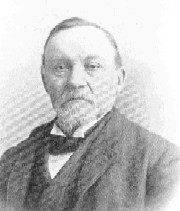
William Moore was a steamship captain, businessman, miner and explorer in British Columbia and Alaska. During most of British Columbia's gold rushes Moore could be found at the center of activity, either providing transportation to the miners, working claims or delivering mail and supplies.

70 Mile House is a community situated on Highway 97 in the Cariboo region of British Columbia, Canada. Its name is derived from its distance from Lillooet, which was Mile 0 of the Old Cariboo Road. Other examples of towns named by their distance from Lillooet on the Old Cariboo Road are 93 Mile House, 100 Mile House, and 150 Mile House. In its heyday, 70 Mile House was a frequent stop for stagecoaches, such as the ones run by Barnard's Express and for Cataline's mule train.

The Cariboo camels were a number of camels that arrived in British Columbia, Canada, as pack animals. The Bactrian camels were used on the Douglas Road and the Old Cariboo Road in 1862 and 1863 to haul freight during the Cariboo Gold Rush. Although the experiment was a failure, the Cariboo camels retained an almost legendary status in local popular culture.
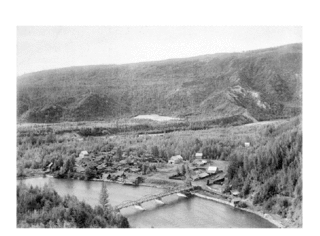
Quesnel Forks, historically Quesnelle Forks, also simply known as "The Forks" or grandly known as "Quesnel City" is a ghost town in the Cariboo region of British Columbia, Canada. It is located the junction of the Quesnel and Cariboo Rivers and is 60 km southeast of Quesnel and only 11 km northwest of Likely.

Horace Cooper Wrinch was a pioneer physician on the Skeena River, British Columbia, medical missionary, a public health insurance advocate and political figure. He represented Skeena in the Legislative Assembly of British Columbia from 1924 to 1933 as a Liberal.